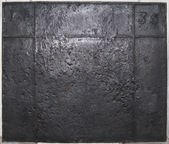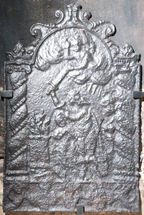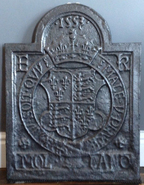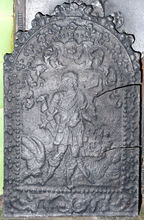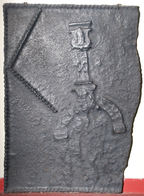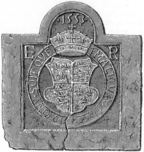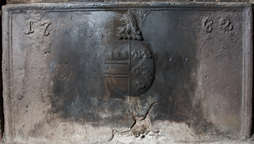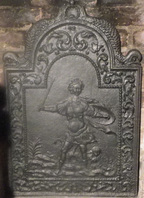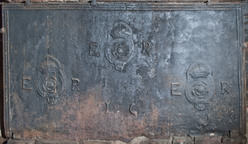-
203
Description: Rectangular; fillet edging; fillet parallel to top edge separating top quarter; two fillets parallel to sides separating side quarters; halves of date in top corner squares.
Notes: Numeral style is typical of first half of 18th century.
Inscription: 17 36
- Decoration tags:
- rectangular (shape)
- fillet (edging)
- individual numbers
- text
Manufactured: in 1736 in England.
Current location: Selly Manor, Birmingham, West Midlands, England.
(part of the Selly Manor museum group)
- Attached to series:
- Date only firebacks
-
1001
Description: Arched rectangular panel with a Salomonic column on each side enclosing a scene of Abraham about to sacrifice Isaac but being restrained by an angel; below, bottom panel of indeterminate decoration (due to corrosion); above each column a burning torch, with symmetrical floriate scrolls over the arch.
Notes: Given the biblical subject, this is probably of German manufacture although the Salomonic columns are more often encountered on English pastiches of the 'Dutch' style.
- Decoration tags:
- 'Dutch' (shape)
- fillet (edging)
- whole carved pattern
- pictorial
- biblical
- architectural
- humans
- objects
Manufactured: in the late-17th to early-18th century possibly in the Siegerland area of Germany.
Current location: Ashmolean Museum Broadway, 65 High Street, Broadway, Worcestershire, England.
(part of the Ashmolean Museum museum group)
- Attached to series:
- Old Testament & Apocrypha firebacks
- 'Dutch' Miscellaneous Firebacks
-
1323
Description: Arched rectangular with broad fillet edges; arched rectangular inset with cavetto edging and armorial design in low relief: circular garter enclosing an ornate Tudor royal shield, surmounted by a crown; date inside top of arch; initials inside top corners of rectangle; a rose in each bottom corner of rectangle; inscription in a separate rectangular panel below, split by garter buckle.
Notes: An altered commercial copy of a Tudor fireback (no. 288) produced by F. Parkin & Sons (Exeter) and advertised in their 1972 catalogue. The width of the edges of the original fireback has been narrowed possibly to reduce weight and cost or for aesthetic reasons.
Copies of this fireback are known.
Inscription: 1553 / E R / HONV SOIT QVY MALE V PENCE / MOL LAND
Arms: Tudor royal - Edward VI
- Decoration tags:
- rectangular with round arch (shape)
- fillet (edging)
- whole carved pattern
- armorial
- royal
- text
Manufactured: in the mid- to late-20th century at Bonhay Foundry, Exeter in England.
Current location: not known.
- Attached to series:
- Edwardian royal armorial firebacks
-
323
Description: Canted rectangle; simulated rope edging; otherwise plain.
Copies of this fireback are known.
- Decoration tags:
- rectangular with canted top corners (shape)
- simulated rope (edging)
- whole carved pattern
Manufactured: in the mid-20th century in England.
Current location: Hardy's Cottage, Higher Bockhampton, Dorset, England.
Museum number: 426390 (part of the National Trust museum group)
- Attached to series:
- Base boards
-
328
Description: Arched rectangular central panel with bead edging; pictorial scene of a figure in Roman dress, holding a large sword, and holding the head of a bearded man in his left hand; below to the left, a naked, decapitated body; above the winged face of a putto between mirrored, scrolled foliage; arched rectangular border with fillet edging; flowers in chain under the arch and down the sides; at the bottom, swirled foliage; on top, a crown between fruit triads.
Notes: Perseus holding the severed head of the Medusa; possibly loosely adapted from a drawing by Crispijn de Passe the elder (1564-1637). Similarities in the design and execution of the pattern suggest a common source with contemporary English firebacks.
- Decoration tags:
- 'Dutch' (shape)
- fillet (edging)
- whole carved pattern
- pictorial
- mythological
- humans
Manufactured: in the early-18th century in England.
Current location: Horsham Museum, Causeway, Horsham, West Sussex, England.
(part of the Horsham Museum museum group)
- Attached to series:
- British 'Dutch' style firebacks
-
378
Description: Fragment (left end only); prob. rectangular; twisted rope edging; slightly angled stamp formed of the end of a firedog with semi-circular feet, and shields at the base and top of the pilaster; V-shaped arrangement of a length of twisted rope stamped twice, the point touching the left edge of the plate and one end touching the top.
Notes: Likely to have been a triple arrangement of firedog impressions.
- Decoration tags:
- rectangular (shape)
- rope (edging)
- simple stamps
- apotropaic
- objects
Manufactured: in the mid- to late-16th century in the Weald area of England.
Current location: Anne of Cleves House, Southover High Street, Lewes, East Sussex, England.
Museum number: LH000.911 (part of the Sussex Archaeological Society museum group)
- Attached to series:
- Firedog stamp firebacks
- Rope design firebacks
- Metalware stamp firebacks
-
467
Description: Arched rectangular with plain edges; arched rectangular inset with cavetto edging and armorial design in low relief: circular garter enclosing an ornate Tudor royal shield, surmounted by a crown; date inside top of arch; initials inside top corners of rectangle
Notes: Discovered by Mr Anthony Hill of the Plymouth ironworks, Glamorgan, in the 1820s, and believed by David Mushet, in his 'Papers on Iron and Steel' to have been cast at the early furnace on the opposite side of the River Taff; a variant of the same date (no. 288) has an inscription on the bottom panel and roses in relief at the bottom corners of the rectangle, which may have been obliterated by fire damage on this casting, the drawing showing it how the artist thought it might have looked originally. The west country source for both of these firebacks offers the possibility of an origin in those parts.
Inscription: HONV SOIT QVE MALE V [illegible]
Arms: Tudor royal - Edward VI
- Decoration tags:
- rectangular with round arch (shape)
- none (edging)
- whole carved pattern
- armorial
- royal
- text
Manufactured: in 1553 .
Current location: not known.
Citation: Mushet, D., 1840, Papers on Iron and Steel (London, John Weale), p. 393.
- Attached to series:
- Edwardian royal armorial firebacks
- Tudor royal armorial firebacks
-
1317
Description: Rectangular; cavetto-moulded edging (top and sides); date, in s florid style, split between top corners; central oval shield of impaled arms surmounted by a crest of a lion's head erased upon a wreath.
Notes: George Worge (1705-65), of Starr’s Green, Battle, sometime steward of the Battle Abbey estate, married Elizabeth (1707-66), eldest daughter of John Collier, town clerk of Hastings, in 1727. The arms of Worge have been variously blazoned, but most commonly they are: gules, a fess ermine cotised argent, in chief three lion’s heads erased of the last; Collier - argent, on a chevron azure, between three unicorns courant couped gules, as many oak sprigs fructed proper. The arms and crest in the same form can be seen on a fireback with an elaborate border (no. 757).
Inscription: 17 62
Arms: Worge impaling Collier (George and Elizabeth Worge)
- Decoration tags:
- rectangular (shape)
- cavetto (edging)
- carved stamps
- individual numbers
- heraldic
- armorial
- text
Manufactured: in 1762 probably at Robertsbridge Furnace, Salehurst in the Weald area of England.
Current location: Great Dixter, Northiam, East Sussex, England.
- Attached to series:
- Worge/Collier series
- Personal armorial firebacks
-
710
Description: Arched rectangular central panel with bead edging; figure of a man with a shield, brandishing a sword in his right hand, a lion behind him; arched rectangular border with astragal and fillet edging; mirrored swirled foliate design; on top, a scallop shell between two descending sea serpents.
Notes: The figure is probably Hercules who was charged by Eurystheus to slay the Nemean lion, one of his 12 labours.
Copies of this fireback are known.
- Decoration tags:
- 'Dutch' (shape)
- astragal & fillet (edging)
- whole carved pattern
- pictorial
- mythological
- animals
- humans
Manufactured: in the mid- to late-17th century in the Siegerland area of Germany.
Current location: Great Dixter, Northiam, East Sussex, England.
- Attached to series:
- 'Dutch' Miscellaneous Firebacks
-
1147
Description: Rectangular shape; triple fillet moulded edging (top and sides); overpressed stamp, repeated three times (top centre and below, to left and right) of a crowned rose within a circular garter, each with the initials ER to left and right respectively; lower centre, the initials IC.
Notes: The rose and crown stamp bears striking similarities to rose and crown designs used to mark some bronze cannon of the Tudor period. The initials ER could refer to Edward VI (1547-53) or Elizabeth I (1558-1603). The initials IC most probably relate to the person for whom the fireback was made.
Inscription: ER [thrice] / I C
- Decoration tags:
- rectangular (shape)
- triple fillet (edging)
- carved stamps
- individual letters
- heraldic
- royal
- text
Manufactured: in the mid- to late-16th century in the Weald area of England.
Current location: in private hands, Rolvenden, Kent, England.
- Attached to series:
- Miscellaneous royal firebacks
- Miscellaneous stamp firebacks
